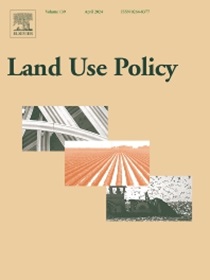Blue landscape fragmentation and ecosystem health in river source regions: A case of Sanjiangyuan National Park, China
IF 5.9
1区 社会学
Q1 ENVIRONMENTAL STUDIES
引用次数: 0
Abstract
Sanjiangyuan National Park (SNP) is a significant river source region in Asia, and its coupled relationship between blue landscape fragmentation (BLF) and ecosystem health (EH) has far-reaching impacts on water ecological security in Asia. The study quantified the spatio-temporal evolution characteristics of BLF and EH from 1993 to 2023, combining the landscape index with the VORS (Vigor-Organization-Resilience-Service) model, while the spatial correlation mechanism was revealed. The results demonstrated that: (1)BLF exhibited substantial type and spatial differentiation, with wetland and glacier retreat being the most pronounced, and the fragmentation degree of the Yangtze River source region exceeding that of the Yellow River and the Lancang River source region. (2) Prior to 2003, the absence of regulatory measures resulted in the proliferation of "Sick" areas, while subsequent to 2013, the implementation of conservation policies fostered the progressive recuperation of EH, culminating in an increase in the proportion of "Very healthy" areas to 27.61 % in 2023. (3)The correlation analysis between BLF and EH further indicated the existence of negatively driven core areas in the SNP, with the driving intensity fluctuating over time. The study innovatively provides a spatial targeting basis for ecological restoration in the plateau national parks, meanwhile, suggesting prioritizing the control of vulnerable nodes in the blue landscape system and strengthening land tenure management mechanisms to cope with the overlapping effects of climate change and anthropogenic disturbances.
河流源区蓝色景观破碎化与生态系统健康——以三江源国家公园为例
三江源国家公园(SNP)是亚洲重要的河流源区,其蓝色景观破碎化(BLF)与生态系统健康(EH)的耦合关系对亚洲水生态安全有着深远的影响。结合景观指数和VORS (Vigor-Organization-Resilience-Service)模型,定量分析了1993 - 2023年城市绿地面积和EH的时空演变特征,揭示了空间关联机制。结果表明:(1)生态系统呈现出明显的类型和空间分异,其中湿地和冰川退缩最为明显,长江源区破碎化程度超过黄河和澜沧江源区;(2)在2003年之前,缺乏监管措施导致“病态”区域的扩散,而在2013年之后,保护政策的实施促进了EH的逐步恢复,最终使“非常健康”区域的比例在2023年增加到27.61% %。(3) BLF与EH的相关分析进一步表明SNP存在负驱动核心区,且驱动强度随时间波动。该研究创新性地为高原国家公园生态修复提供了空间定位依据,同时建议优先控制蓝色景观系统中的脆弱节点,加强土地权属管理机制,以应对气候变化和人为干扰的重叠效应。
本文章由计算机程序翻译,如有差异,请以英文原文为准。
求助全文
约1分钟内获得全文
求助全文
来源期刊

Land Use Policy
ENVIRONMENTAL STUDIES-
CiteScore
13.70
自引率
8.50%
发文量
553
期刊介绍:
Land Use Policy is an international and interdisciplinary journal concerned with the social, economic, political, legal, physical and planning aspects of urban and rural land use.
Land Use Policy examines issues in geography, agriculture, forestry, irrigation, environmental conservation, housing, urban development and transport in both developed and developing countries through major refereed articles and shorter viewpoint pieces.
 求助内容:
求助内容: 应助结果提醒方式:
应助结果提醒方式:


